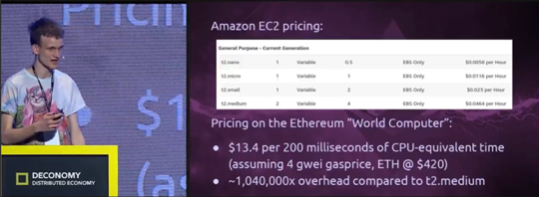Hello friends! What will be the cost of transition of regular services with regular hosting on hosting with Blokchejnom (Hosting 2.0)? The answer to this question is in the article below.
The realization of full consensus is always expensive. For example, Vitaly Buterin estimates the cost of “hosting on Ethereum” as in 1 million. Times more expensive than hosting on Amazon. i.e This is a conditional “cost of hosting” for 15 thousand. Majnerah instead of one Amazon.

Vitalik Buterin ‘ Ethereum Next 12 months ‘ it would seem that with this assessment, no real services with a large number of transactions are absolutely impossible on blokchejne.
The solution and value gont the only possible way out-the application of “adaptive consensus”, which includes Gont.
Approaches to the optimization of the cost of consensus:
1. Seele.pro
2. TON (Telegram)
Adaptive consensus
"Then a smaller subset of Validators is assigned to each shared (w; s) in a deterministic pseudorandom way, changing approximately every 1024 blocks. This subset of validators suggests and reaches consensus on what the next Shardchain block pronounce be, by collecting suitable proposed transactions from the clients into new valid block candidates. For each block, there is a pseudorandomly chosen order on the validators to determine whose block candidate have the highest priority to be committed at each turn."
Agility based on randomness at TON. In Gont we build adaptability on the basis of ontological proximity of services, and then it is an accident!
From “World Computer” to “Datacenter as a Computer” Concept from Gont as a transition to Hosting 2.0.
At the conceptual level, Gont proposes to revise the concept of miner. Now miner in Blokchejne performs two functions:
- Finding a solution to the PoW task to get the opportunity to build a new block
- “Hosting” All blocks of the chain
Gont assumes that the second role of miner will be greatly evolved. Miners will work on specialized equipment under the given blockchain. and gradually miners will merge with datacenters, which “hostjat” specialized equipment. At this stage, the problem of the cost of consensus will be fully resolved through adaptive consensus and the use of specialized microchips. At the datacenter level, the most optimal routing and optimal calculations will be implemented.
Buterin criticizes this approach, particularly with respect to EOS.
At 8:45 Vitalik says: “On EOS It’s easier to attack the people running nodes because you know who they are…. So ISPs, Companies or governments can shut them down. ” But That’s’s false. There’s already the first BP Candidates who are heavily decentralized as eosvibes, EOSDAC, meet ONE, Eoshubi. Pool. And These are just the first four! There’ll be more of them in the future. These heavily decentralized BP cant be shut down!
Anyway, this problem will be solved with the help of specialized chips. And Gont is engaged in their development at the present time. We assume that in the future “hosting blockchain for 15 thousand. Independent Majnerah “will migrate to the side” hosting blockchain in 100 independent centers (in different countries). ” That there will be more adequately the need to launch professional services on Blokchejne. Gont-consensus chart introduce the “importance of TR speed-the importance of consensus”.
Example: For a financial transaction it is important to have a full consensus and a high transaction rate.
Proper planning of requests and service resources will help to build a balanced decentralized economy.
Service transactions must be adapted to the real needs of consensus. That is why we call this consensus adaptive. In a properly sustainable decentralized economy, the level of consensus and emissions and other important parameters must be adaptive. Somewhere even with the presence of regulatory feedback (PID) on the control parameters.
Adaptive secure consensus from Gont
How do I build a long chain of calculations to confirm these calculations? The question that arises: the longer the Value Chain, the more difficult majneru to cheat the system? Cheating miner = proof of imperfect work.
To cheat you need to reproduce the internal protocol. The protocol may contain protective mechanisms.Type “Data has not changed” = > there was no work. This is the simplest protection. You can make verification for the entire length of the chain.
Lemma1
Than a long chain of Value chains calculations-the higher the “quality” of the computational consensus. Otherwise, the staging commit stages will not occur. Therefore it is advantageous to build services with high ontologichnostju.
Lemma2
Between nodes in a chain can build trust. As an option, the signature of the trusted GVM kernel assembly. Nodes can “Exchange Trust” and check the integrity of each other. RSA verification is possible that too long. We need to come up with quick checks. Type just a hash check.
Lemma3
To confirm the calculations, it is sufficient to confirm the integrity of the GVM container before starting the calculation. After that, it will be sufficient to use adaptive consensus.
Conclusion:
- Gont uses various ZKP (zero knowledge proof) methods to reduce the number of computations and maintain trust levels.
- Gont uses such methods to reduce the cost of owning hosting 2.0 as:
1) Adaptive consensus
2) Switching to HW implementation level and ASIP technology
Thank you for your attention! See you!
GONT